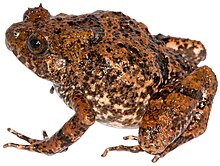| Rhombophryne vaventy | |
|---|---|

| |
| Conservation status | |
 Endangered (IUCN 3.1) | |
| Scientific classification | |
| Domain: | Eukaryota |
| Kingdom: | Animalia |
| Phylum: | Chordata |
| Class: | Amphibia |
| Order: | Anura |
| Family: | Microhylidae |
| Subfamily: | Cophylinae |
| Genus: | Rhombophryne |
| Species: | R. vaventy |
| Binomial name | |
| Rhombophryne vaventy Scherz, Ruthensteiner, Vences & Glaw, 2014 | |
Rhombophryne vaventy is a large species of frogs of the Madagascar endemic microhylid subfamily Cophylinae. It is one of the largest members of its genus.
Range and distribution
Rhombophryne vaventy is endemic to the Marojejy massif in northern Madagascar, where it was originally described from two individuals, captured at high altitude.
Description
Rhombophryne vaventy measure up to 52 mm (2.0 in). In life, the dorsal skin is highly textured. It lacks webbing between the fingers and toes, and has very long legs. It possesses four unequally sized spines above each eye, characteristic of its species group.
Habitat and ecology
Rhombophryne vaventy is found in montane rainforest at high altitude (~1,300 m (4,300 ft) above sea level) on the Marojejy massif. Like most Rhombophryne species, R. vaventy is a terrestrial or possibly semi-fossorial frog. It is a generalist predator, and its diet is known to include relatively large arthrosphaerid pill millipedes of the genus Zoosphaerium. Nothing is currently known of its breeding or calling behaviour.

Taxonomy
Rhombophryne vaventy was confused with R. serratopalpebrosa until the taxonomy of the R. serratopalpebrosa species complex began to be resolved. It differs from R. serratopalpebrosa in its size, eye spines, skin texture, and numerous other characters. Ongoing resolution of this complex has yielded several new species, including R. ornata and R. tany.
References
- ^ IUCN SSC Amphibian Specialist Group (2020). "Rhombophryne vaventy". IUCN Red List of Threatened Species. 2020: e.T79130249A177140091. doi:10.2305/IUCN.UK.2020-3.RLTS.T79130249A177140091.en. Retrieved 20 November 2021.
- Glaw, Frank; Vences, Miguel (2007). A Field Guide to the Amphibians and Reptiles of Madagascar (3rd ed.). Köln, Germany: Vences & Glaw Verlags GbR. pp. 118–119. ISBN 978-3-929449-03-7.
- Frost, Darrel R. (2015). "Rhombophryne vaventy Scherz, Ruthensteiner, Vences, and Glaw, 2014". Amphibian Species of the World: an Online Reference. Version 6.0. American Museum of Natural History. Retrieved 1 May 2015.
- ^ Scherz, Mark D.; Ruthensteiner, Bernhard; Vences, Miguel; Glaw, Frank (2014). "A new microhylid frog, genus Rhombophryne, from northeastern Madagascar, and a re-description of R. serratopalpebrosa using micro-computed tomography". Zootaxa. 3860 (6): 547–560. doi:10.11646/zootaxa.3860.6.3. PMID 25283290.
| Taxon identifiers | |
|---|---|
| Rhombophryne vaventy | |
This Microhylidae article is a stub. You can help Misplaced Pages by expanding it. |